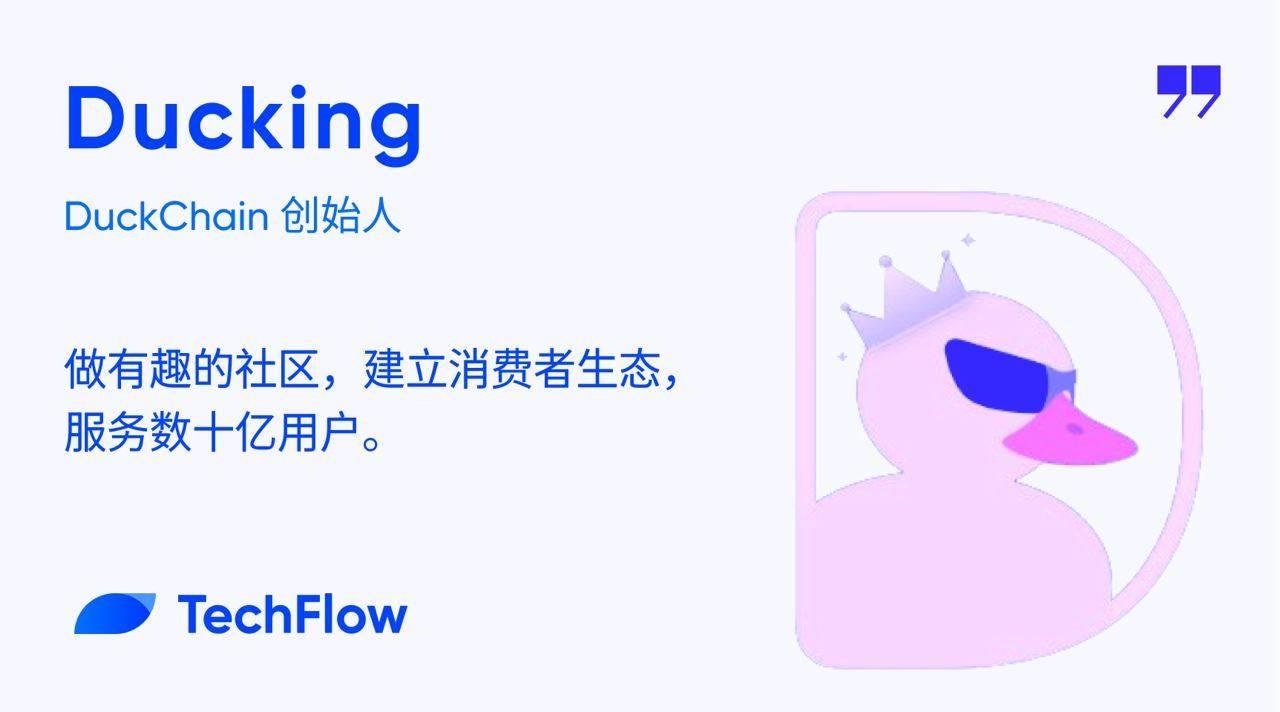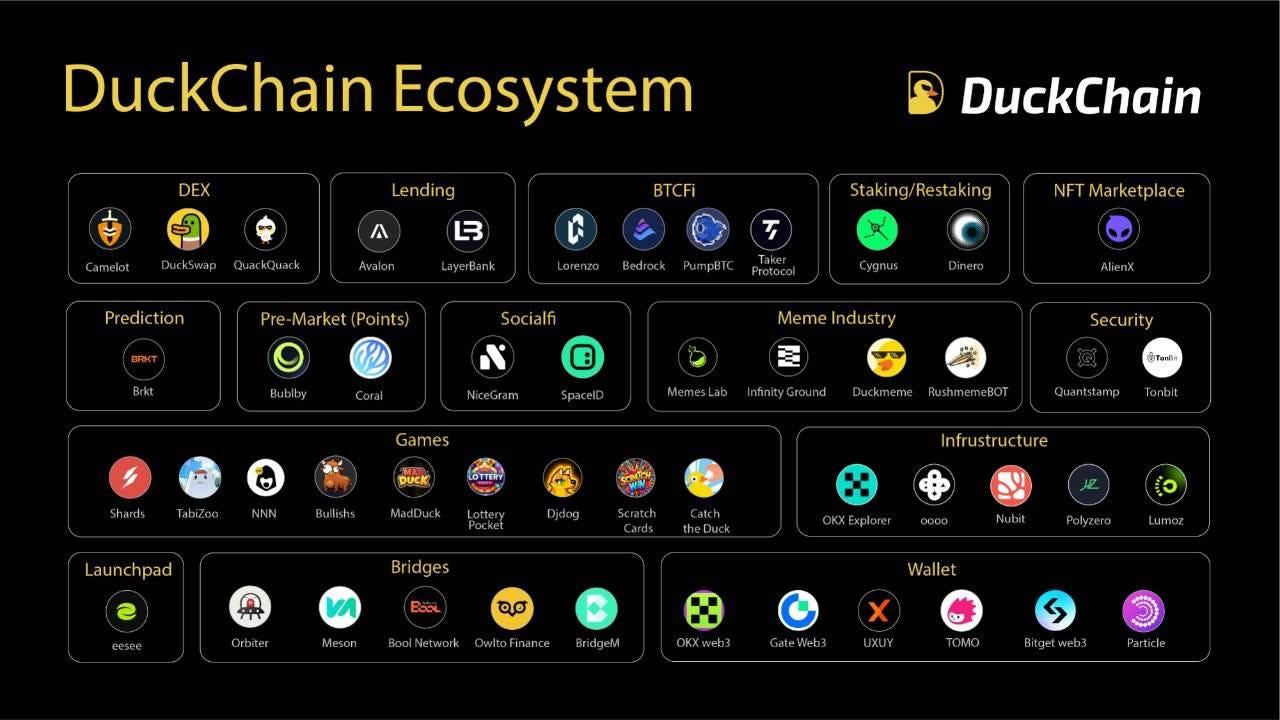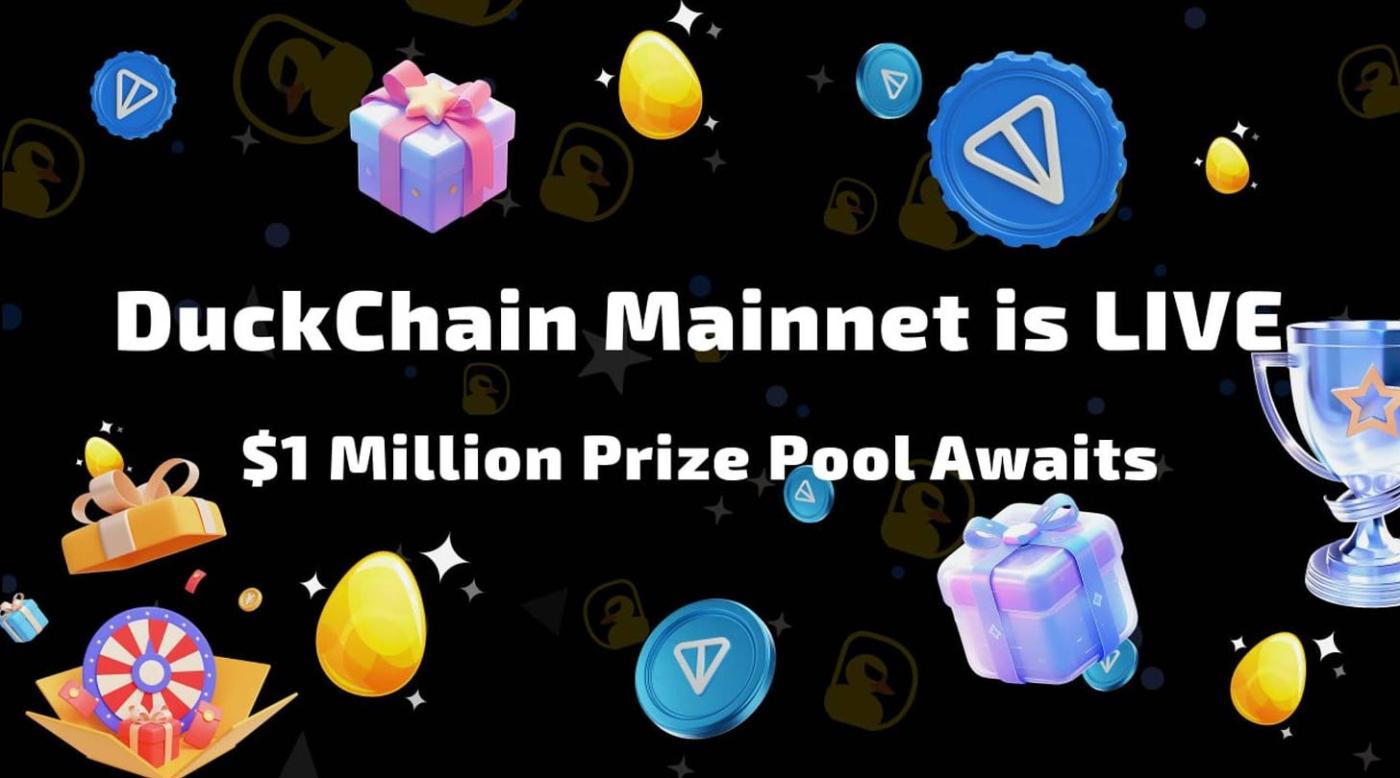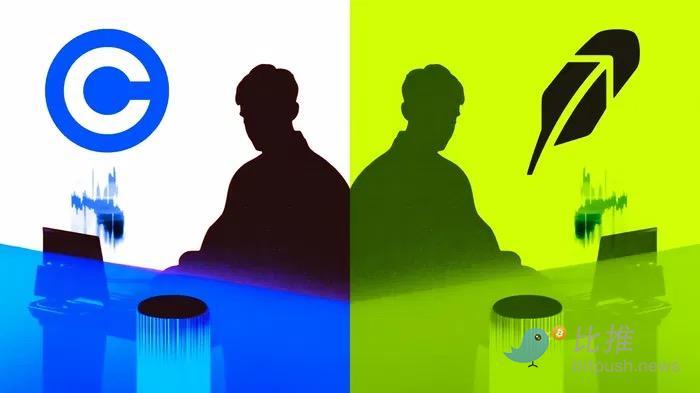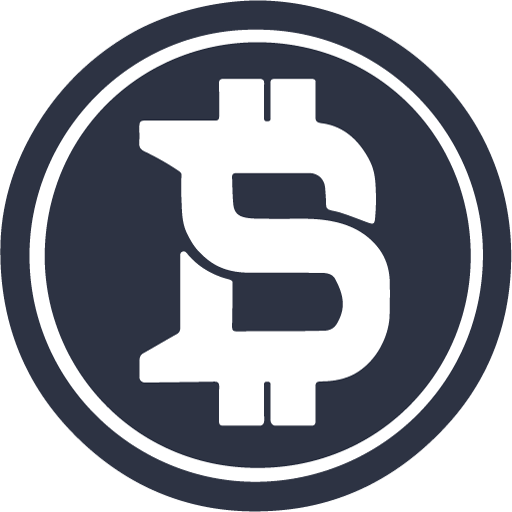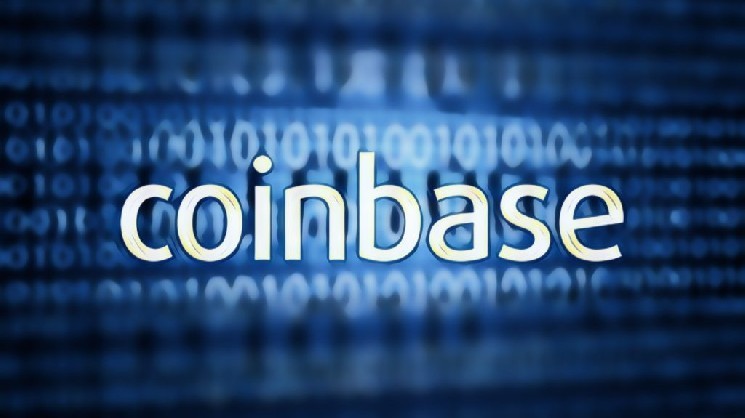Written by: TechFlow
The crypto market is experiencing an unprecedented "zoo" cycle, with a series of animal-themed projects shining brightly one after another.
In the gaming field, the cat (Catizen) and mouse (Hamster) war is leading the trend of earning points;
In the MEME market, hippos, squirrels, spider monkeys, and eagles have taken turns, repeatedly pushing this highly speculative and absurd comedy track to new heights;
And in the public chain ecosystem, in addition to the community-cultured Monad and Berachain, the consumer Layer DuckChain supported by the magic of TON + Arbitrum is the one that the community looks forward to the most this year.
On November 18, DuckChain announced the official launch of its mainnet, and at the same time launched the innovative ISO concept, supporting users to convert Telegram Stars into on-chain Stars and participate in on-chain interactions, further reducing the cognitive and participation threshold for users. In less than a week after its launch, DuckChain has achieved the impressive achievement of "the number of active wallets that have recharged Stars exceeding 1 million", and as of the time of writing, the on-chain transaction volume has exceeded 5 million.
On this important milestone, we are honored to have an in-depth conversation with the founder of DuckChain, Ducking.
Thanks for reading TechFlow! Subscribe for free to receive new posts and support my work.
In the current competition of public chains, finding the right track and doing a good job in development are equally important, and for those who are new to DuckChain, at first glance, this project seems to have many labels: the first consumer Layer in the TON ecosystem that is EVM compatible, supports Arbitrum, has more than 1 million paid users on the testnet, and has a total user base of over 10 million...
Although it may seem dazzling, Ducking, who has rich investment analysis and quantitative experience, is very good at using concise language to summarize the essence of the problem:
As the first consumer Layer to provide an EVM development environment for developers on TON, DuckChain aims to bring tens of billions of Telegram users from off-chain to on-chain, making TON seamlessly compatible with EVM, BTC and other ecosystems.
When talking about "what kind of applications are more likely to receive the favor of DuckChain", Ducking frankly said:
DuckChain will prioritize supporting applications with the potential to break through the circle, truly bringing Web2 users into Web3 and providing users with diversified application scenarios and a seamless interaction experience, including but not limited to MEME, GameFi, SocialFi and innovative DeFi projects.
In this issue, let's follow Ducking's sharing and take a look at the past and present of DuckChain's unique "consumer Layer" and the community culture led by this sunglasses-wearing little yellow duck with a user base of millions.
Entering the Founder Ducking: Believing that TG is the Web3 Mass Apotion Traffic Entrance
TechFlow: I'm very glad to have the opportunity to have an in-depth conversation with you. First, please introduce yourself (you can share some of your past educational experience, Crypto work/entrepreneurial experience, and the circumstances that led to the creation of DuckChain, etc.).
Ducking:
Hello everyone, I am Ducking, the founder of DuckChain. I'm very glad to have this opportunity to have an in-depth exchange with you all.
I went all-in on the Crypto industry in 2019. Prior to that, I worked in a Web2 investment company doing investment analysis and quantitative work, and later obtained a master's degree in business at the University of Cambridge. After learning about Crypto, I decided to drop out.
In the Crypto field, my experience has mainly been from exchanges to VCs to quantitative funds. In 2021, I once founded a Studio focused on innovative R&D of Crypto products, and provided product support for many projects that were later listed on Binance and Coinbase.
Last September, I started paying attention to the TON and Telegram ecosystem. At the time, the market was not very optimistic about it, but I have always firmly believed that Telegram will be the direction of the next Web3 Mass Apotion. It was at this time that our team planned to develop some innovative products on TON, and in the process we found that the underlying architecture of TON was very unfriendly to developers, and many developers needed to spend several months to master the basics, which made me conceive the idea of improving the developer environment of TON.
In April this year, the Tap to Earn Game on TON started to heat up, and we initially felt the huge traffic dividend of Telegram, which is something we have never seen in the nearly ten years of Crypto development, and we are more convinced of the significance of Telegram as an ecosystem traffic entrance.
However, as some explosive projects emerged, people also found the shortcomings of the underlying technical infrastructure of TON, as well as the lack of an active developer ecosystem, which ultimately boils down to the fact that the FunC language of TON is unfamiliar to 99% of developers.
Therefore, if TON wants to enter the next stage, the core problem should be to introduce more excellent developers. This made us conceive the idea of introducing the EVM development environment and developers into the TON ecosystem. If developers can use Solidity language to develop on TON, we believe this will bring the next wave of TON.
TG's Billion User Reserve + EVM Powerful Infrastructure + Full Integration of Liquidity = DuckChain
TechFlow: In the eyes of many people, DuckChain seems to have many impressive labels, such as the first consumer Layer in the TON ecosystem, the first EVM compatible L2 in the TON ecosystem, the first non-EVM Layer to support Arbitrum, etc. If you can only introduce DuckChain in one sentence, how would you introduce it?
Ducking:
As the first consumer Layer to provide an EVM development environment for developers on TON, DuckChain aims to bring tens of billions of Telegram users from off-chain to on-chain, making TON seamlessly compatible with EVM, BTC and other ecosystems.
TechFlow: In the current environment where the threshold for launching a chain is getting lower and lower, the competitive landscape of hundreds of rivers and streams makes people more concerned about what pain points this chain specifically solves. As the first consumer Layer in the TON ecosystem, how was this unique market positioning determined? In the face of the constant discussion in the community about consumer applications, what kind of consumer Layer does DuckChain aim to build?
Ducking:
The core problems we want to solve can be summarized in the following three points:
Enable developers to enter the development of consumer products for Telegram and TON more seamlessly.
Through abstracting accounts and chain abstraction functions, make it easier for Telegram users to go on-chain, weaken users' understanding of the chain, and lower the threshold for users to enter Web3.
Provide richer consumer products for Telegram users.
Therefore, the very clear concept is that DuckChain is born for consumers, and we position ourselves as the next-generation Web3 consumer super platform prepared for the billions of Telegram users. We hope that Telegram users can experience rich consumer applications, from GameFi, SocialFi to various application-level products.
Accordingly, our infrastructure is prepared for consumers: for developers, we hope they can more easily build consumer applications on our chain; for consumers, we hope they can experience various consumer products seamlessly on our chain, weakening the complex concepts of Web3.
TechFlow: Why did DuckChain choose TON? Do you think that only TON can further promote the realization of DuckChain's vision of a consumer Layer?
Ducking:
TON is the only ecosystem that has both a solid technical foundation and a huge user reserve. Its integration with Telegram has potential far beyond other public chains, allowing us to directly reach billions of users and thus quickly advance the vision of a consumer Layer.
Therefore, although other chains also have their own characteristics, TON's unique positioning is most in line with DuckChain's mission.
Although the TON ecosystem is currently thriving, its ecosystem development is still in the early stage, and the vast majority of Telegram users have not yet participated in the TON ecosystem, which also brings huge opportunities and growth space for the expansion of Duckchain.
TechFlow: It is undeniable that the TON ecosystem is one of the best performing blockchain ecosystems this year, but it is also impossible to ignore that the TON ecosystem is also facing problems such as complex development, high user threshold, and isolated ecosystem liquidity. In the face of these challenges, how will DuckChain leverage its advantages and solve its weaknesses to promote its consumer Layer vision?
Ducking:
On the one hand, DuckChain has lowered the development threshold for developers by introducing the EVM development environment, and on the other hand, we have greatly weakened the difficulty for users to use the chain through chain abstraction technology.
In addition, I believe that the most unique advantage of DuckChain is that we present the complex Web3 Token concept to users in the form of DuckChain Star, allowing users to easily understand that DuckChain Star is similar to Telegram Star, or a functional points currency like Q-coin, thereby greatly reducing the initial learning cost for users to understand new concepts.
In terms of liquidity, DuckChain is committed to integrating the liquidity of the EVM and BTC ecosystems into TON, solving the problem of isolation, and providing users with a seamless Web3 experience.
TechFlow: We notice that there are many one-click chain deployment technology stacks, and DuckChain has chosen to build based on the Arbitrum Orbit technology architecture, thereby bringing the EVM development framework to the TON ecosystem. What considerations were behind this choice? What does this mean for developers? How will the cooperation between the two parties empower the development of their respective ecosystems to achieve a win-win situation?
Ducking:
With the rising popularity of the TON ecosystem, many EVM developers have the need to explore the TON ecosystem, but the unfamiliar development environment has become a threshold that discourages them.
Arbitrum Orbit provides DuckChain with a highly optimized Rollup architecture and extensive developer support, ensuring that DuckChain's EVM environment is stable and efficient.
Through Duckchain, EVM developers can use their existing development experience to quickly develop on TON, while enjoying the efficient technical support provided by Arbitrum.
The partnership between Duckchain and Arbitrum Orbit will not only bring a new group of TON users to Arbitrum, but DuckChain will also leverage its technology to improve performance and attract more developers, jointly expanding the ecosystem influence.
TechFlow: Breaking the liquidity isolation problem of the TON ecosystem and further integrating the liquidity of the EVM ecosystem and even the Bitcoin ecosystem is another major problem that DuckChain is committed to solving. In this cycle where the problem of liquidity fragmentation is becoming more and more prominent, how does DuckChain achieve this?
Ducking:
By building cross-chain bridges and a unified liquidity pool, DuckChain helps users achieve free circulation of assets between TON, EVM and BTC.
At the same time, we have introduced a liquidity incentive mechanism to attract users and some well-known projects (such as PumpBTC, BedRock, Lorenzo, etc.) to inject funds into the ecosystem, fundamentally improving the integration of liquidity.
TechFlow: Over the past period of time, DuckChain's ecosystem dynamics have been frequent, with successive official announcements of cooperation with projects such as Nubit, Particle Network, and Tomo Wallet. We know that ecosystem building is an important part of project development, and the continuous improvement of the ecosystem map will also bring users a better participation experience. Therefore, through this question, can you lead everyone into the panoramic view of the DuckChain ecosystem and help readers understand the DuckChain ecosystem map more deeply?
Ducking:
DuckChain is committed to building a Web3 platform with both innovation and practicality, with developer support, consumer applications, and ecosystem cooperation as the core.
By providing an EVM development environment, DuckChain has greatly reduced the threshold for developers, while providing traffic support, professional guidance and ecosystem funding to help developers quickly realize project implementation and achieve success.
In terms of consumer applications, DuckChain focuses on popular areas such as Meme, GameFi, SocialFi and DeFi, providing users with diversified application scenarios and a seamless interaction experience.
In addition, DuckChain continues to make efforts in ecosystem cooperation, working hand in hand with many well-known partners to jointly build key infrastructure such as decentralized exchanges, lending protocols, incubation platforms, and oracles, providing a more solid ecosystem support for developers and users.
Winning over a million users: Escaping monotony, community participation can also be fun
TechFlow: As an important channel for users to interact with the Duck Planet, DuckChainBot, with its fun and unknown gameplay, has been deeply loved by the community since its launch, and some community members even believe that the product design of DuckChainBot largely reflects DuckChain's community building philosophy. How do you view this view? In terms of community culture, what kind of construction philosophy will DuckChain practice?
Ducking:
The gameplay of DuckChainBot does fully reflect our "community-centric" operating philosophy.
In terms of design style, DuckChainBot is different from most "serious" public chains, using the cute duck image to get close to our users, which has achieved very good results.
In addition, we are very proactive in building cooperative relationships with other well-known projects, and provide users with the projects and rewards of our partners through various interesting activities, which is also a concrete manifestation of our high attention to community demands.
Under this operating philosophy, DuckChain has gradually built a community culture with its own characteristics of fun, innovation and openness, and constantly encourages users to enter the Web3 world in a relaxed and interesting way, ultimately forming the currently highly active ecosystem.
TechFlow: According to previous data, the number of paid users on the DuckChain testnet has exceeded 1 million, the Miniapp daily active users have exceeded 2 million, and the total number of users has exceeded 10 million. In the context where most users are already tired of doing tasks and receiving rewards, what do you think are the reasons for DuckChain's outstanding performance in the testnet stage?
Ducking:
The success of DuckChain's testnet is due to its leading core concepts and unique advantages.
By solving the key pain points of developers and users, DuckChain provides an efficient and friendly EVM development framework, a design that lowers the threshold for on-chain, and powerful infrastructure support.
In addition, TON's unique Telegram traffic reserve endows DuckChain with wider exposure and participation, while DuckChain's fun and low-threshold interactive gameplay further attracts a large number of users to participate. Furthermore, the active community culture and incentive mechanism have further enhanced user enthusiasm. All of these have laid the foundation for the excellent performance of DuckChain's testnet.
TechFlow: As the mainnet is officially launched, can you introduce to us: Currently, as an ordinary user, how can I participate in the DuckChain ecosystem more efficiently?
Ducking:
Our mainnet has just been launched, and we have brought users an Eggs Season main line activity, and innovatively proposed the concept of ISO (Initial Star Offering), where users only need to convert their Telegram Star into DuckChain Star with one click, and then they can participate in the chain with DuckChain Star.
Of course, in addition to our DuckChainBot, we will also regularly launch some excellent and fun ecosystem projects for users to experience, so please pay attention to our social media announcements.
TechFlow: Finally, developers are the core figures in ecosystem building. As the mainnet is officially launched, it is also a time of great construction in the ecosystem. As a developer, what type of project would be more favored by DuckChain? Additionally, what kind of support can be obtained by participating in the construction of DuckChain?
Ducking:
DuckChain will prioritize supporting applications with the potential to break through, truly bringing Web2 users into Web3, including but not limited to Meme, GameFi, SocialFi and innovative DeFi projects.
We hope that project parties will fully unleash their creativity to provide users with unique and easy-to-participate experiences.
Developers participating in the construction will receive comprehensive support, including ecosystem rewards, project consulting, community promotion covering 10M+ user resources, and funding support through connections with top investment institutions.
TechFlow is a community-driven in-depth content platform, committed to providing valuable information and thoughtful perspectives.
Community:
Public account: TechFlow
Subscription channel: https://t.me/TechFlowDaily
Telegram: https://t.me/TechFlowPost
Twitter: @TechFlowPost
Join WeChat group, add assistant WeChat: blocktheworld
Donate to TechFlow, receive blessings and permanent records
ETH: 0x0E58bB9795a9D0F065e3a8Cc2aed2A63D6977d8A
BSC: 0x0E58bB9795a9D0F065e3a8Cc2aed2A63D6977d8A


